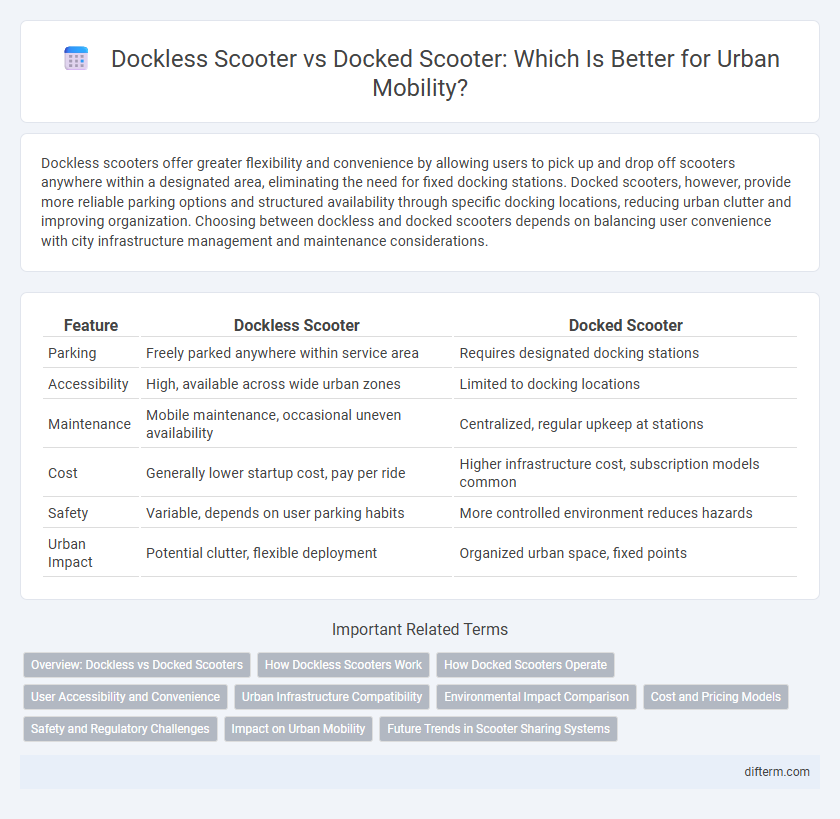Dockless scooters offer greater flexibility and convenience by allowing users to pick up and drop off scooters anywhere within a designated area, eliminating the need for fixed docking stations. Docked scooters, however, provide more reliable parking options and structured availability through specific docking locations, reducing urban clutter and improving organization. Choosing between dockless and docked scooters depends on balancing user convenience with city infrastructure management and maintenance considerations.
Table of Comparison
| Feature | Dockless Scooter | Docked Scooter |
|---|---|---|
| Parking | Freely parked anywhere within service area | Requires designated docking stations |
| Accessibility | High, available across wide urban zones | Limited to docking locations |
| Maintenance | Mobile maintenance, occasional uneven availability | Centralized, regular upkeep at stations |
| Cost | Generally lower startup cost, pay per ride | Higher infrastructure cost, subscription models common |
| Safety | Variable, depends on user parking habits | More controlled environment reduces hazards |
| Urban Impact | Potential clutter, flexible deployment | Organized urban space, fixed points |
Overview: Dockless vs Docked Scooters
Dockless scooters offer flexible, on-demand urban mobility without fixed parking stations, enabling users to pick up and drop off scooters anywhere within the service area. Docked scooters require designated docking stations, ensuring organized parking and easier fleet management, which reduces sidewalk clutter and vandalism. Both models address last-mile transportation needs but differ in convenience, infrastructure requirements, and operational challenges.
How Dockless Scooters Work
Dockless scooters operate through GPS-enabled, app-controlled systems that allow users to locate, unlock, and rent scooters without fixed stations. These scooters use integrated sensors and IoT technology to provide real-time tracking, battery status, and ride analytics, enhancing fleet management efficiency. The flexibility of dockless scooters supports last-mile connectivity and urban micro-mobility by enabling spontaneous usage and diverse drop-off locations.
How Docked Scooters Operate
Docked scooters operate through designated charging stations where users pick up and return the vehicles, ensuring organized parking and reducing street clutter. These stations use secure locking mechanisms connected to a central system that tracks scooter availability and battery status in real-time. The structured docking infrastructure supports fleet maintenance efficiency and enhances urban space management compared to dockless alternatives.
User Accessibility and Convenience
Dockless scooters offer greater user accessibility by eliminating the need for fixed stations, allowing riders to pick up and drop off scooters anywhere within a service area. Docked scooters provide structured convenience with designated parking spots that reduce clutter and ensure availability at reliable locations. The choice between dockless and docked scooter systems hinges on balancing flexible access with organized, predictable service points.
Urban Infrastructure Compatibility
Dockless scooters offer greater flexibility by allowing riders to pick up and drop off scooters anywhere, reducing the need for fixed infrastructure and adapting well to varied urban landscapes. In contrast, docked scooters rely on designated docking stations that require significant space and infrastructure investment, which can limit deployment in densely built or historic urban areas. Cities with diverse infrastructure often integrate dockless models more seamlessly, enhancing last-mile connectivity without extensive urban modifications.
Environmental Impact Comparison
Dockless scooters offer flexible use but often contribute to higher environmental waste due to improper disposal and shorter lifespans, while docked scooters promote organized charging and maintenance, leading to longer durability and reduced e-waste. Life cycle assessments indicate docked scooters generally have a lower carbon footprint per ride, attributed to centralized battery management and reduced need for frequent redeployment. Urban planners emphasize docked systems to minimize environmental degradation and enhance sustainable micro-mobility infrastructure.
Cost and Pricing Models
Dockless scooters typically operate on a pay-per-ride pricing model with lower upfront costs but variable per-minute fees, offering flexible usage without the need for docking stations. Docked scooters involve higher infrastructure investment and fixed docking fees but often provide subscription plans or discounted rates for frequent riders, ensuring predictable pricing. Cost efficiency depends on user behavior, with dockless scooters favoring casual, short trips and docked scooters appealing to regular commuters seeking cost stability.
Safety and Regulatory Challenges
Dockless scooters face significant safety and regulatory challenges due to their unpredictable parking habits and increased risk of accidents in pedestrian areas, necessitating strict speed limits and geofencing technology. Docked scooters offer more controlled deployment and parking, reducing clutter and improving user accountability, yet still require robust maintenance protocols and compliance with local traffic laws. Both models must address concerns such as rider helmet use, nighttime visibility, and data sharing with municipal authorities to enhance urban mobility safety.
Impact on Urban Mobility
Dockless scooters offer increased flexibility and accessibility by allowing users to pick up and drop off scooters anywhere, which enhances last-mile connectivity and reduces reliance on cars. Docked scooters, anchored to specific stations, encourage organized parking and reduce sidewalk clutter, contributing to tidier urban environments and fewer pedestrian obstructions. Both models contribute to sustainable urban mobility by decreasing carbon emissions and alleviating traffic congestion, but dockless systems require robust management to address potential misuse and imbalanced distribution.
Future Trends in Scooter Sharing Systems
Future trends in scooter sharing systems indicate a growing preference for dockless scooters due to their flexibility and urban integration, enabling users to pick up and drop off scooters anywhere within geofenced zones. Advanced GPS tracking, AI-powered fleet management, and improved battery technologies are streamlining operations and enhancing user experience for both dockless and docked models. Smart city initiatives are increasingly incorporating scooter-sharing networks to reduce traffic congestion and carbon emissions, with hybrid systems combining docked reliability and dockless convenience gaining traction globally.
dockless scooter vs docked scooter Infographic

 difterm.com
difterm.com